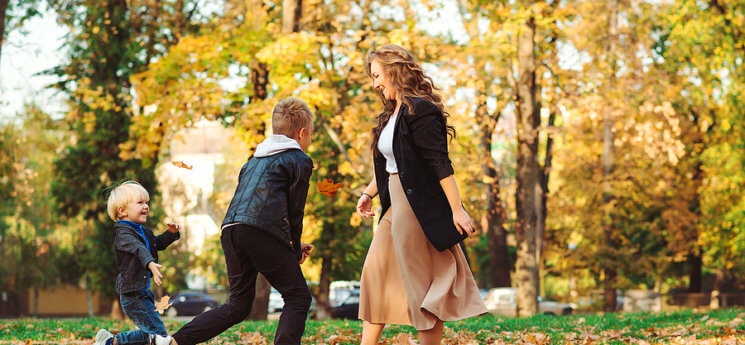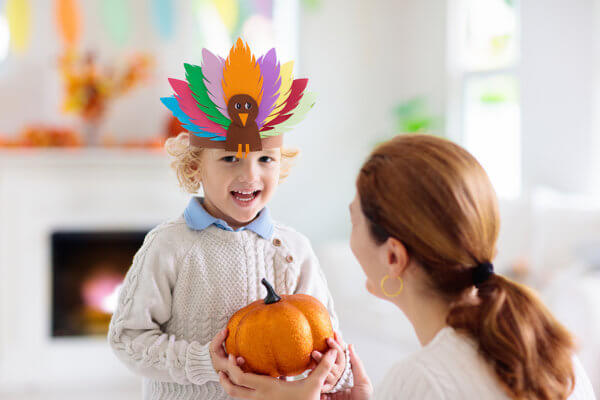Exploring nature together is a wonderful way to spend high-quality time with your young child. And now is the perfect time for outside discovery. Being surrounded by the sights, smells, temperatures and textures of the natural environment will help you stay in the moment, allowing you to cherish this special time together.
Below, we’ve listed some of our favorite parent-child activities that can be enjoyed in any natural setting, whether walking through the countryside, along a beach, across a park, or through a forest. Remember to spend plenty of time just walking and talking as well. Keeping active has both short-term and long-term benefits for you both.
Nature Mandala
In a natural environment, ask your child to collect nearby objects from nature that she finds beautiful, interesting, or special. Sticks, stones, and fallen leaves provide lots of different colors and textures. (Make sure your child doesn’t pick parts off growing plants, or pick up living creatures.) Together, place these “treasures” in a circle on the ground. Then, with mindfulness and care, create designs inside the circle, using the additional objects or perhaps drawing designs in the dirt or sand with a stick. Talk about the objects you both have chosen, and the designs you’ve created, and how they make your mandala special.
Keep your focus on the here and now. Express joy in creating something beautiful and interesting together. It is this feeling that you both will take home with you, rather than the mandala itself. When it’s time to move on, your child can decide whether to scatter the objects again, or leave the mandala for someone else to discover. You will have the memory to keep and share with each other in the years ahead.
The Five Senses
As you walk through nature with your child, help him focus on each sense, one at a time, to really appreciate the special surroundings and what makes them so special.
- Focus on sight: Talk about what you both see, large and small. What’s moving? What’s still?
- Focus on sound: What do you hear when you really pay attention? Listen, not only to the birds, but perhaps the wind through the trees as well. Do you hear the movement of animals? Running water?
- Focus on touch: Together, feel different natural objects and help your child describe them – rough, smooth, cool, warm, bendable, stiff, etc. Also notice if you feel cool air on your skin, or perhaps the warmth of the sun.
- Focus on smell: Talk about the different smells of the tree bark, flowers, even the soil.
- Focus on taste: Stress the importance of not tasting plants in nature unless an adult has given permission, because some plants can make people sick. Instead, bring a vegetarian picnic to enjoy in the natural surroundings. Talk about how the fruits and vegetables come from plants that have been grown by farmers; even the bread comes from grain grown in the ground.
Nature Box
Give your child a small box with a lid. It could be a plastic box or an old shoe box. Your child may want to decorate it with drawings, or glue on pictures of nature. When walking in an area that allows you to collect, encourage your child to pick up small things that she finds interesting to store in the nature box, things she will want to look at again later. (Make sure no living things are collected.) Storing a magnifying glass in the nature box will also encourage further exploration of sticks, rocks, seeds, pods, and dried leaves during quiet times at home. Showing the items to someone else, and talking about where she found them, will help her relive her special experience.
It’s an Ant’s Life
Find ant activity outside. With your child, watch the colony up close, but far enough away not to disturb their activity. Talk about what you see. What are the ants doing? Why? How are they communicating with each other? Why do they live altogether (in a colony)? Drop a few crumbs of food close to the ant activity. Talk about what happens.
Colors in Nature
This activity works best at a picnic table, but could also be done on the forest floor, or on a sandy beach. Talk about the different colors you see in nature. Mimic the colors of nature with blobs of paint on the paper. Work together with your child on one paper. The blobs of paint can be placed randomly as you identify the color words. Alternatively, you can talk about the layers of color in nature, from bottom to top, and mimic them in your art. Perhaps dark and light brown paint is blobbed on at the bottom of the page because you see dirt and rocks at ground level. Many different shades of green for bushes may be the next layer up.
Don’t hesitate to help your child mix colors in the lid of the paint set, showing how adding a little yellow, or a little blue, to the green can help capture the greens seen in nature. Similarly, there are many different hues of brown. Add some extra water for light brown and less water for dark brown. Remember to include the colors of the beautiful sky. Post your painting on the fridge at home so you can both be reminded of your special time together in nature.
Materials needed: Child’s set of watercolor paints, two brushes, a cup of water with lid, a piece of paper, and a paper towel.
Magnify It
Take magnifying glasses with you on your next walk in nature. Plastic ones are fine. They don’t need to be glass. Show your child how to focus, holding the magnifying glass close to the object. Inspect the top and bottom of different leaves. Using the magnifying glasses, examine the trunks of different trees, the petals of flowers, blades of grass, a snail shell, even a handful of dirt. If you are at the beach, there’s also a multitude of possibilities: sand, shells, seaweed, stones, etc. Talk about what you see. Designs? Patterns? Color variation? You will both be amazed at the intricacies of nature!
Listen to Nature Game
Find a spot to sit quietly in nature without many people and car sounds. Sit in a way that you and your child are touching, side-by-side or back-to-back. Explain the listening game: Sit very still, with eyes closed, for 30 seconds. Listen to the sounds of nature. Ignore all the people-made sounds.
Then talk about what you heard. What was making each sound? How did they make you feel? Did you hear any sounds made by animals? What do you think they were doing? What was your favorite sound?
Zoom-In Game
In nature, stand still. Discuss what the two of you see around you, taking turns naming as many objects as you can (trees, bushes, sky, bird, etc.). Now move very close to a tree, plant, or the ground. What do you see now that you didn’t see before? Discuss colors and textures, as well as additional objects you notice now that you’re close up. Talk about how you might be the only people who have ever really seen that object up close.
Light & Dark
Walk through a forest, or a park with trees. Notice the sunlight and shadows created by the sun and trees. Discuss how the trees block the light and give cool shade to life below. Which plants like full sunshine? Which plants grow in the shade? If surfaces aren’t too hot, together touch the ground or rock in the sun and then the same in the shade. Discuss warm/cool. Look for animals big and small. Do they prefer sun or shade? Why do you think they live here? Talk about where these animals would find food and safety.
Photo Collage
Bring your camera phone along with you on this nature walk. Ask your child if he would like to help you take pictures and make a collage (a big picture made by gluing many smaller pictures on a paper). As you walk, help your child take a photo of anything in nature that brings him joy. It could be something beautiful or interesting, a close-up picture or a distant scene. Talk about what the two of you are seeing each time you snap a picture, and how you each feel about it. For example, “Look at that beautiful tree! It’s so big! I love the way the branches move in the wind, don’t you?”
Take distance photos as well as close-ups. Take a picture of your child – or even better, of you and your child together – looking at something in nature. (A close-up of a parent and a child’s hands holding something together makes a great photo!)
At home, print out some of the photos. Together with your child, glue them onto poster board. Glue the picture of your child, or you and your child, in the middle of the collage. Hang it on a wall where you both can see it every day.
Celebration Tree
With your child, purchase a tree (or bush) to plant on your property (or a nearby public area if allowed), to celebrate a happy event, such as a birthday. Discuss what the tree needs to grow, and involve your child in its care. Help your child create a special journal – complete with drawings and photos – of the tree over time. Make sure to record the date of each entry. Write down what your child dictates to you, as she describes the tree. What does it look like? How does its height compare with the height of your child? What did it feel like to buy it and plant it together? How does your child feel every time she looks at it? Your tree and your child will be treasures to watch grow and thrive over the years!
However you and your child choose to spend time in natural surroundings, the most valuable part will be the connection the two of you share, with each other and with nature. In today’s world, it’s all too easy to become distracted and preoccupied by demands and stressors, making it difficult to fully appreciate our surroundings and each other. Spending time together in nature is a beautiful way to model the ability to be truly present for your child while building lifelong memories. These activities will not only enhance your relationship through quality time together; they will also teach your child the valuable skills of being able to unplug, slow down, prioritize family, and appreciate the world around us. Enjoy every minute of it!
Safety note: Being outside in nature is a wonderful bonding experience for you both, but you do need to be mindful of common safety measures. Make sure your child doesn’t touch poison ivy or poison oak. If you’re not sure what it looks like, google it before your outing. If still not sure, remember the jingle, “Leaves of three, let it be!” If you visit an area where there may be ticks, do a “tick check” when you get home and make sure your child bathes before bedtime. But don’t let these extra precautions keep you both from one of the most enjoyable experiences people can share with each other – time in nature.
Authors
Kottie Christie-Blick, climate change education consultant, instructor at the University of San Diego, mother. Allison Detloff, child clinical psychologist, mother. Katie Roetker, kindergarten teacher, mother-to-be.




